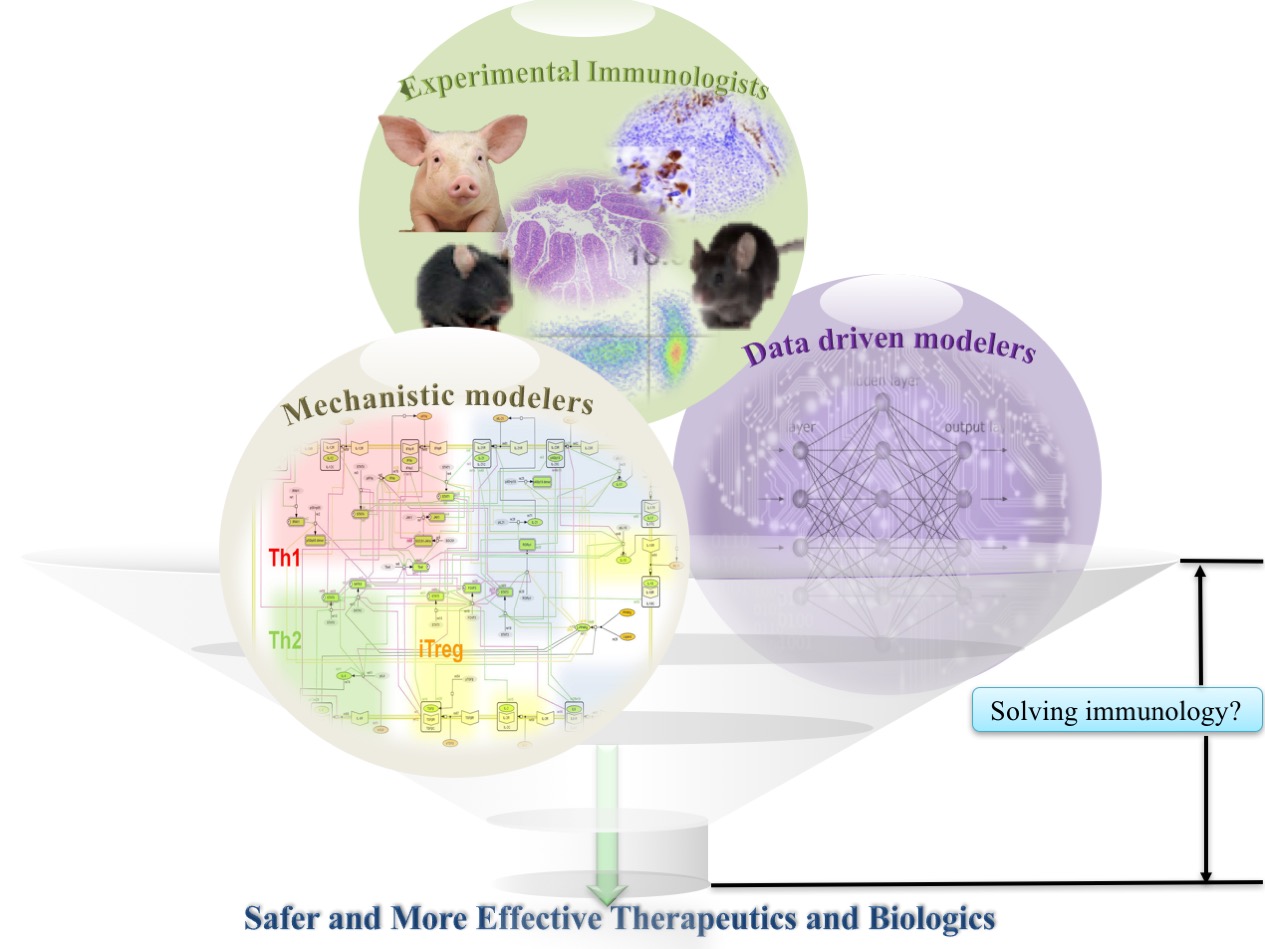Solving Immunology?

“Solving Immunology?” has been accepted for publication in Trends in Immunology. The review is the culmination of the “Complex Systems Science, Modeling and Immunity” workshop convened by the National Institute of Allergy and Infectious Diseases (NIAID).
The white paper, a collaboration by 14 prominent immunologists and computational biologists, aims to define the need for systems immunology approaches, mechanistic modeling and data-driven modeling and the value these approaches can add when used in combination with traditional experimentation. This white paper serves as “a roadmap for bridging the immunologist-modeler divide in order to accelerate insight into newly discovered mechanisms of immune system function and the translation of data into individualized treatment for infectious and immune-mediated diseases.”
The balance between health and disease is exquisitely controlled by complex massively and dynamically interacting gene networks, immune signaling pathways, dietary choices, the microbiome with its trillions of gut bacteria, our body’s metabolism, the immune system and nutrition-microbiota-host interplay. When interactions among genes, the environment and the immune system become out of sync, disease follows. Dysregulation of immune and inflammatory pathways is at the core of many diseases facing mankind in the twenty first century. These diseases are multi-factorial, exhibit great patient-to-patient variability, and often are intractable to both traditional therapy and reductionist insight.
The resounding message of “Solving Immunology?” is aligned with ongoing work at NIMML. Three projects are highlighted within the article: ENteric Immunity SImulator (ENISI), an agent-based modeling platform developed by the Nutritional Immunology and Molecular Medicine Laboratory (NIMML), in silico clinical trials of Crohn’s disease patients based in artificial intelligence systems, and LANCL2 therapeutics as a use-case for the value of computational approaches in immunology and drug development.
A fundamental challenge for immunology in the post-genomic era is to ascertain what is the optimal way to leverage focused, hypothesis-driven and hypothesis-generating immunology research to understand how immune system behavior in health and disease emerges from molecular, genetic, epigenetic, cellular and environmental modulatory elements.
“Even relatively simple mathematical models can improve insight from existing data. Better integration of mechanistic modeling approaches into immunology research can optimize the choice of what and when to measure, and sharpen the hypothesis generation process,” said Josep Bassaganya-Riera, a Professor of Immunology and Director of the Nutritional Immunology and Molecular Medicine Laboratory, at Virginia Tech, and one of the authors of the paper. “We have successfully combined the power of computational modeling with immunology experimentation to characterize new immunoregulatory targets such as PPARs, LANCL2 and NLRX1 in infectious and immune-mediated diseases. Pharma companies spend billions of dollars every year in validating new therapeutic targets. We envision a role for modeling and informatics as the first step toward identifying and validating new targets for safer and more effective drugs and biologics.”
The NIMML models have recently been highlighted as the Model of the Month on the BioModels Database and were also featured in the Stanford Biomedical Computation Review article “Computing the Gut.” The NIMML has been instrumental in shaping the career paths of immunologists interested in computational modeling and bioinformatics through summer schools and symposia in computational immunology.
This work is a starting point to show traditional immunologists and modelers that collaborative efforts can greatly accelerate the generation of new knowledge about the immune system as well as facilitate discoveries that may not be possible independently. This approach is not only important in the current research environment, but also in the training of hybrid students that can lead the next generation of translational immunology research.
For More Information:
Precision Medicine: https://nimml.org/news/detail/modeling-enabled-precision-medicine-and-health-thrust-at-virginia-tech
Next Gen Scientists: http://www.the-scientist.com/?articles.view/articleNo/46364/title/Learning-Bioinformatics/
Computational immunology: https://nimml.org/news/detail/new-computational-immunology-book-explains-how-to-study-10-billion-immune-c
H. pylori modeling: https://nimml.org/news/detail/modeling-the-role-of-lancl2-in-regulating-helicobacter-pylori-host-interact
Computing the Gut: http://biomedicalcomputationreview.com/content/computing-gut
Medicinal Chemistry and Efficacy: https://biotherapeuticsinc.com/index.php/news/detail/bt-11-oral-therapeutic-for-inflammatory-bowel-disease
Toxicology studies: https://biotherapeuticsinc.com/index.php/news/detail/toxicology-experiments-demonstrate-that-bt-11-has-a-benign-safety-profile
DDW: https://biotherapeuticsinc.com/index.php/news/detail/biotherapeutics-presents-at-ddw-2016
About NIMML
The NIMML Institute is a 501 (c) (3) non-profit public charity foundation focused on a transdisciplinary, team-science approach to precision medicine at the interface of immunology, inflammation, and metabolism. The NIMML Institute team has led numerous large-scale transdisciplinary projects and is dedicated to solving important societal problems by combining the expertise of immunologists, computational biologists, toxicologists, modelers, translational researchers, and molecular biologists. The Institute is headquartered in Blacksburg, VA. For more information, please visit www.nimml.org or contact pio@nimml.org.
